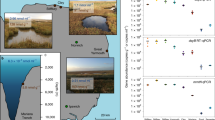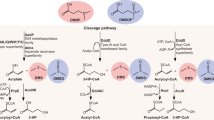Abstract
3-Mercaptopropionate (3-MPA) is a major organic sulphur compound (thiol) recently detected in the anoxic pore waters of coastal marine sediments1. A chemical mechanism for the formation of 3-MPA has been identified as the abiotic addition of H2S to the double bond of acrylate2. A natural source of acrylate (for the addition reaction) is dimethylsulphoniopropionate (DMSP) which yields dimethylsulphide (DMS) and acrylate upon enzymatic cleavage3,4. DMSP occurs in plants, particularly those in saline environments where it fulfils an osmotic function5. Here we present evidence that 3-MPA is generated from the biotransformations of DMSP as well as the sulphur-containing amino acids methionine and homocysteine. Additionally, 3-MPA is metabolized in sediments. In view of these findings we suggest that 3-MPA is a central metabolite in both catabolic and assimilatory sulphur metabolism in general.
Similar content being viewed by others
References
Mopper, K. & Taylor, B. F. in Organic Marine Geochemistry ACS Symp. Ser. No. 305 (ed. Sohn, M.) 324–339 (Am. Chem. Soc., Washington, DC, 1986).
Vairavamurthy, A. & Mopper, K. Nature 329, 623–625 (1987).
Cantoni, G. L. & Anderson, D. G. J. biol. Chem. 222, 171–177 (1956).
Kiene, R. P. & Visscher, P T. Appl. envir. Microbiol. 53, 2426–2434 (1987).
Vairavamurthy, A., Andreae, M. O. & Iversen, R. L. Limnol Oceanogr. 30, 59–70 (1985).
Mopper, K. & Delmas, D. Analyt. Chem. 56, 2557–2560 (1984).
Cline, J. D. Limnol Oceanogr. 14, 454–458 (1969).
Fahey, R. C., Brown, W. C., Adams, W. B. & Worsham, M. B. J. Bacteriol. 133, 1126–1129 (1978).
Luther, G. W., Church, T. M., Scudlark, J. R. & Cosman, M. Science 232, 746–749 (1986).
Sabbagh, E., Cuebas, D. & Schulz, H. J. biol. Chem. 260, 7337–7342 (1985).
Cuebas, D., Beckmann, J. D., Frerman, F. E. & Schulz, H. J. biol. Chem. 260, 7330–7336 (1985).
Cooper, A. J. L. A. Rev. Biochem. 52, 187–222 (1983).
Greene, R. C. J. biol. Chem. 237, 2251–2254 (1962).
Durell, J., Anderson, D. G. & Cantoni, G. L. Biochim. Biophys. Acta 26, 270–282 (1957).
Kiene, R. P. & Capone, D. G. Microbial Ecol. (in the press).
Drotar, A. M., Fall, L. R., Mishalanie, E. A., Tavernier, J. E. & Fall, R. Appl. envir. Microbiol. 53, 2111–2118 (1987).
Drotar, A. M., Burton, G. A., Tavernier, J. E. & Fall, R. Appl. envir. Microbiol 53, 1626–1631 (1987).
Maw, G. A. & du Vigneaud, V. J. biol. Chem. 176, 1037–1045 (1948).
Author information
Authors and Affiliations
Rights and permissions
About this article
Cite this article
Kiene, R., Taylor, B. Biotransformations of organosulphur compounds in sediments via 3-mercaptopropionate. Nature 332, 148–150 (1988). https://doi.org/10.1038/332148a0
Received:
Accepted:
Issue Date:
DOI: https://doi.org/10.1038/332148a0
- Springer Nature Limited
This article is cited by
-
Production of dimethyl sulfide and acrylic acid from dissolved dimethylsulfoniopropionate during the growth of Prorocentrum minimum
Journal of Applied Phycology (2022)
-
Determination of dissolved and particulate thiols in Lake Biwa water and extracted fulvic acids by solid phase extraction followed by HPLC with fluorescence detection
Limnology (2018)
-
Catabolism of dimethylsulphoniopropionate: microorganisms, enzymes and genes
Nature Reviews Microbiology (2011)
-
Interactions between Volatile Reduced Sulfur Compounds and Metals in the Seine Estuary (France)
Estuaries and Coasts (2008)





